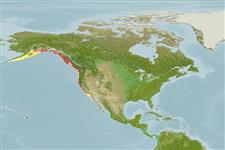Malacostraca |
Decapoda |
Cancridae
Environment: milieu / climate zone / εύρος βάθους / distribution range
Οικολογία
; εύρος βάθους 0 - 90 m (Αναφ. 78177). Subtropical, preferred 9°C (Αναφ. 107945); 61°N - 30°N, 168°W - 116°W (Αναφ. 78486)
Eastern Pacific: Nunivak and Kodiak Islands, Alaska to Isla San Martin, Baja California. Subtropical to temperate.
Length at first maturity / Μέγεθος / Weight / Age
Γεννητική Ωρίμανση: Lm ? range ? - ? cm Max length : 20.0 cm CW αρσενικό/απροσδιόριστο; (Αναφ. 78486)
Depth range is from intertidal to about 90 m. Max size from male specimen captured off Punta Banda, Baja California (Ref. 78177). Forages on shores protected from wave action. Juveniles and mating pairs occur in the intertidal zone only on nocturnal high tides (Ref. 78483). Buries itself in the substrate during periods of inactivity (Ref. 78491). Excavating predator (Ref. 78493).
Life cycle and mating behavior
Γεννητική Ωρίμανση | Αναπαραγωγή | Γεννοβολία | Eggs | Γονιμότητα | Larvae
Most species produce a single brood each winter but may reach up to two or three broods per year and the reproductive life span is about 4 years. The cumulative number of broods produced over the maximum life span is about 4 broods.
Jensen, G.C. 1995 Pacific Coast Crabs and Shrimps. Sea Challengers, Monterey, C.A. 87p. (Αναφ. 78177)
IUCN Red List Status
(Αναφ. 130435: Version 2025-1)
CITES status (Αναφ. 108899)
Not Evaluated
Not Evaluated
Threat to humans
Human uses
αλιεία: Εμπορικό(ά)
FAO - αλιεία: landings | FishSource | Η θάλασσα γύρω μας
Εργαλεία
Περισσότερες πληροφορίες
PhysiologyΚατανάλωση οξυγόνου
Human RelatedStamps, coins, misc.
Διαδικτυακές πηγές
Estimates based on models
Preferred temperature
(Ref.
115969): 8 - 12.1, mean 9.6 (based on 82 cells).
Fishing Vulnerability
Low vulnerability (10 of 100).
Climate Vulnerability
Moderate to high vulnerability (50 of 100).
Nutrients : Calcium = 109 [35, 184] mg/100g; Iron = 1.59 [1.21, 1.97] mg/100g; Protein = 20.2 [19.2, 21.3] %; Omega3 = 0.285 [0.185, 0.386] g/100g; Selenium = 48.3 [-31.7, 128.3] μg/100g; VitaminA = 0 μg/100g; Zinc = 1.79 [1.17, 2.40] mg/100g (wet weight); based on
nutrient studies.
